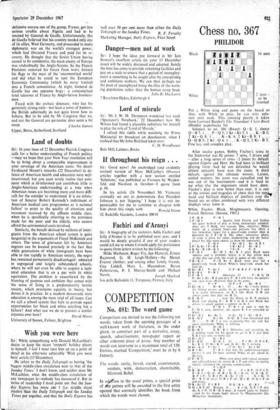Chess no. 367
PHILIDOR
Black
White
men
2 men— to be inserted Put a White king and pawn on the board so that, with White to play, he can win; solu- tion next week. This amusing puzzle is taken from Leonard Barden's The 'Guardian' Chess Book (Hodder paperbacks 5s). Solution to no. 366 (Bwee): Q – R 5, threat Q – B 7. I . P – Q 5; 2 Kt –Kt 5. 1 . . . K – B 3; 2 Kt – Q 8. 1 . . . K – K 4; 2 Kt – B 8. 1 . . . Q–Q B'S; 2 Kt – Q 4. I . . . K–Q 2, 2 Kt – B 7. Fine key and complex play.
After twelve games, Bobby Fischer's score in the Interzonal was 8{ points: 7 wins, 3 draws and —after a long series of rows-2 losses by default against Gipslis and Hort. He had been in brilliant playing form—had he not defaulted he would almost certainly have won the event. A third default, against the ultimate winner, Larsen, settled matters; his score was cancelled and he was out of the tournament—and it is hard -to see what else the organisers could have done. Fischer's play is now better than ever; it is one of the ironies and tragedies of chess that the lucid and brilliant displays of intellect overmge. board are so often combined with very different displays away from it.
White, Fischer. Black, Miagmasuren. Opening, French Defence. (Sousse, 1967.)
P -K 4 P - K 3 2 P - Q 3 . . . Against both French and Sicilian this quiet method of play is being increasingly adopted; there are, I think, two reasons. One, objective; White builds up a gradual king's-side pressure but offers a less immediate target for a queen's-side counter than b provided by 2 P - Q 4. The other, subjective; plenty of scope is given for subtle manoeuvring and the better Player has thus more chance to show his superiority.
2 . . . P- Q 4 3 Kt- Q 2 Kt- K B 3 4 P- K Kt 3 P- B 4 5 B - Kt 2 Kt- B 3 6 K Kt - B 3 B - K 2 70-0 0 -0
8 P - K 5 Kt -Q 2. Kt - K 1 gives Black more
options and is probably better; it Is fine points inch as this that can settle the result in games of this type.
9 R-
P - Q Kt 4. Black must play for queen's-side 's-side break before White's king's-side attack basa built up.
10 Kt-B 1 P-Kt S 11 P-K R 4 P-Q R4 12 B- B 4 P - R 5 13 P - R 3 . . . Otherwise 13 . . P - R 6; 14 P - Kt 3. Kt - It 4 and then P - B 5 will force the queen's side open more effectively than In the game.
13 . . . P x P 14 P x P Kt -R 4
15 Kt - K 3 B - it 3 15 . . Kt - Kt 3 looks better; the bishop proves unable to do anything on R 3 and it is useful defensively on B 1 (the Black Q R can always come into play via It 2). 16 B - R 3! . . . now the threat to K P prevents 1. Black ever playing P - K B 3 or B 4 and Black has always to guard against a capture on K 3. 16 . .P -Q 5 P - B S at once is met by P -.0 4; now, however, the square K 4 is conceded to White.
17 Kt - B I Kt-Kt 3 18 Kt - Kt 5 Kt- Q 4
19 B -Q 2 B x Kt 20 Q- R 5 was threatened and 19 . . . P - R 3 is too weakening—but the test has equal drawbacks; White is winning.
208x B Q - Q 2 21 Q- R 5 K R - B 1. Defensise, not attacking; he Is making room for his queen to go to K 1 and then K B I (see note to move 23).
22 Kt - 0 2 Kt - B 6
23 B-B ° Q-K 1 23 . . . P X B?; 24 P X P, K-R11; 25 Kt -B 3! and 26 Kt -Kt S winning.
24 Kt - K 4 P - Kt 3 23 Q - Kt 5 Kt x Kt
26 it x Kt P - B S. Too late: his earlier-inaccuracies (moves /3 and 15) have allowed White to get ahead in the race. 27 P - it 5! . . . White now plays with typical accuracy and self-confidence: he scorns R x P and relics on having QP
27 exactly calculated the ensuing complications.
28R-R4! R-R 2. 28 P x B P; 29 PXP, P- B 8= Q eh; 30 R x Q. R x R ch; 31 K- R 2l.
P x P; 32 R X P!, - Kt 2 (32 . . . K x R; 33 Q-R4chetc.); 33 BxPch!.QxB; 34QXPeh
29 Ban-Kt 2!! P 13•P 30 Q - R 6 0 -13 1 31 QXRP chi Resigns. 31 . K Q; 32 P x P dbk cb, K X P; 33 B - K 4 mate. A superb game by Fischer —and by no means badly played by Miagmasuren (the Mongolian champion).










































 Previous page
Previous page